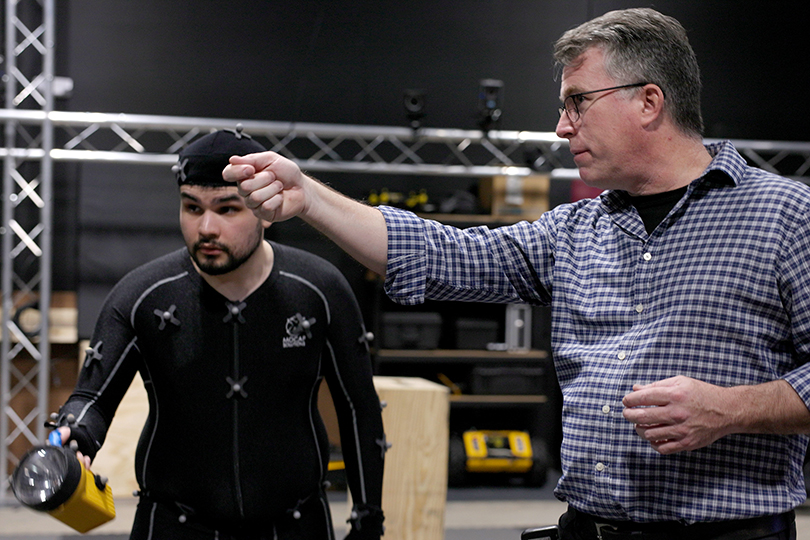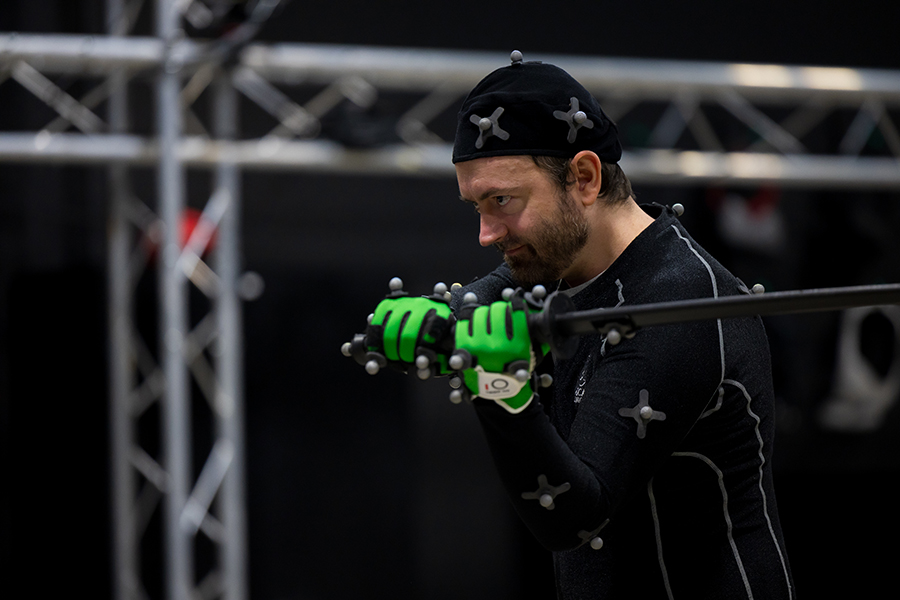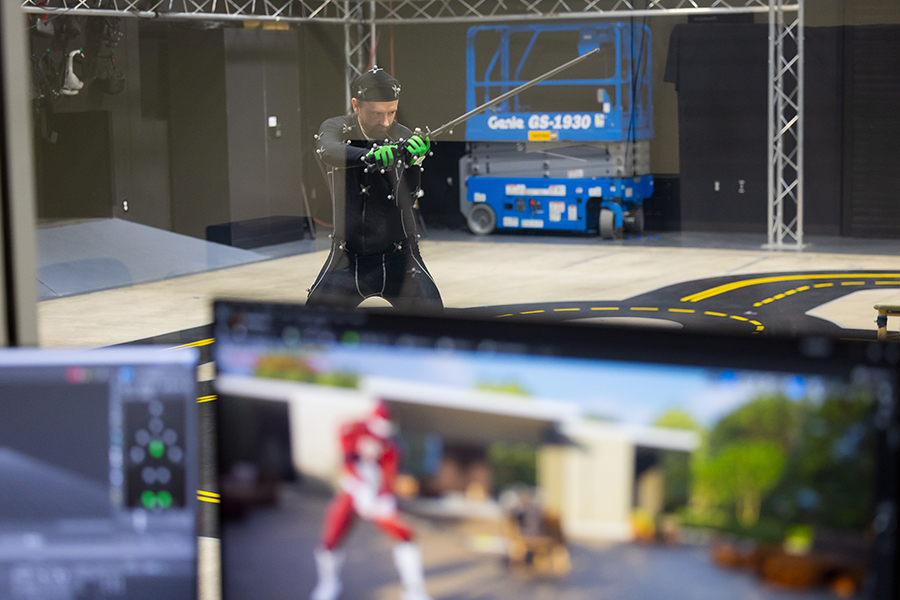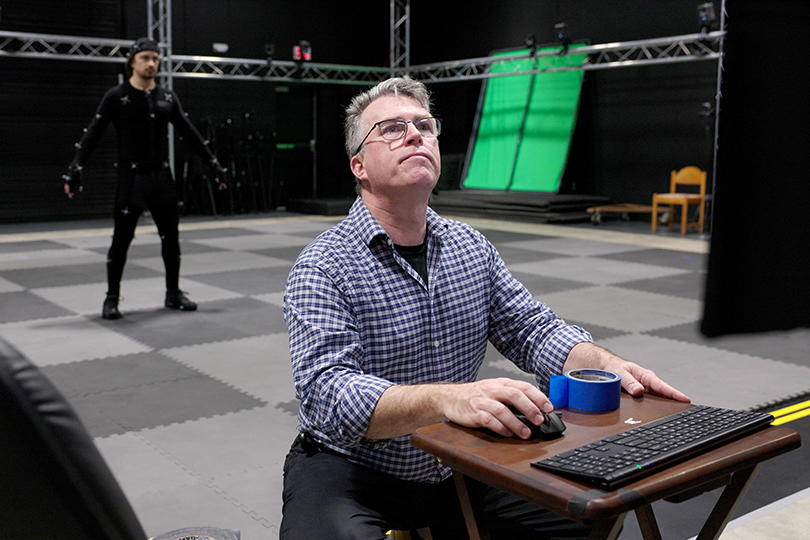Visualization Students Bring Creative Visions To Life At Starlab Motion Capture Facility

Inside a nondescript-looking warehouse at the Texas A&M RELLIS campus in Bryan, Visualization graduate student Axel Galindo stomps toward a classmate, trying his hardest to portray the fearsome stride of a Minotaur — the legendary beast from Greek mythology described as part man, part bull.
Across the room, a computer connected to dozens of precisely placed cameras tracks and records the performers’ movements, translating them into data that will be used to create a 3D animation of the heart-pounding confrontation.
“I had to make sure I was this mean, strong guy,” Galindo said in late March after a busy morning of rehearsing and shooting the scene. An animator with plans to work in the film industry after graduation, Galindo said he wanted his performance to channel the intimidating size and physicality of animated characters like Shrek and The Incredible Hulk. “You want to be expressive enough that when you have the data, it translates (well) from real life into animation,” he said.
As he approaches his prey, Galindo pauses a moment, then unleashes a ferocious roar, sending the other actor into a hasty retreat as the rest of the class laughs and instructor Michael Walsh nods his approval.
A veteran of the Hollywood visual effects scene, Walsh is now an associate professor of practice at Texas A&M University, with dual appointments to the Department of Mechanical Engineering and the College of Performance, Visualization and Fine Arts’ nationally recognized Visualization program. He serves as director of Starlab, a state-of-the-art motion capture and virtual production facility founded by University Distinguished Professor Dr. James Hubbard in 1999 with funding from the Governor’s University Research Initiative and the Chancellor’s Research Initiative. The lab is part of the Texas A&M Engineering Experiment Station and focuses on emerging technologies like virtual and augmented reality, smart system design and autonomous vehicles.
At its facility on the RELLIS campus, the Starlab team operates a professional-grade motion capture stage that Walsh’s Motion Capture Animation (VISA 619 / VIST 419) students have been using to create their final projects. Using this rapidly developing technology — the same kind employed in big-budget feature films like “Avatar” — students in the class are able to create just about anything they can dream up, from epic battles to more lighthearted vignettes.
For their first forays into the world of motion capture, Walsh’s students are starting small, producing animated shorts with data captured on the 1,700-square-foot stage — the largest of its kind at a college or university. Walsh was brought to A&M specifically to run the motion capture facility, as he brings years of on-stage experience working on large motion capture projects for feature films including “Avatar,” “Beowulf” and “The Adventures of TinTin.”
“Most students have never been on a motion capture stage. … It’s interesting to see the wonder in people’s eyes when they see the capabilities,” Walsh said. “Right after spring break, we do a full week of capture out here. The students can bring their friends, they can bring other actors to direct, or they can suit up and capture their own data.”
For the process to work, performers must wear a specially designed skin-tight suit covered in “markers” — small spheres that reflect infrared light, allowing the cameras to precisely track and record their movements. The computer then interprets that data and translates it onto a digital 3D model, which moves in real time along with the actor.
“The performer has the ability to walk over to a monitor like it’s a mirror and adjust their performance to see what it looks like,” said Walsh. “We had (that capability) on ‘Avatar’ and it’s only gotten better since then.”
Markers can also be placed on physical objects like furniture and props, effectively placing them in the same digital space as the actors’ models. So, when a performer swings a prop sword in the real world, its digital counterpart cuts through the air with the same precision and velocity. All this motion capture data is then cleaned up and used by artists to create a complete, polished animation.
As Walsh explains it, the whole process has a way of revealing hidden talents, letting students express their creativity in a way that benefits the entire class.
“I had a student who was so incredibly quiet, he never said a word, and then he gets out here and starts breakdancing, spinning around on his head and doing all this crazy stuff,” he said. “Any student can make use of anyone else’s data from the week, and so a lot of people ended up using his data.”

New Frontiers
While motion capture is most often associated with entertainment products like movies and video games, the technology has found its way into a variety of other industries, Walsh said, with major applications in fields like robotics, defense and space exploration.
Researchers from Texas A&M’s Department of Aerospace Engineering have even used Starlab to research human mobility in a low-gravity environment, he explained, using a treadmill and suspension system to simulate the sensation of walking on the moon.
“There’s all kinds of applications. I’m always telling my students that,” Walsh said. “It’s always interesting to see what projects we could be working on, and it’s very interesting as a guy with a (Master of Fine Arts degree) to be working with engineers.”
Starlab has also done extensive work combining motion capture with virtual and augmented reality to create detailed simulations of real-world spaces. Walsh and his team have replicated parts of the RELLIS campus and Disaster City, and they are currently working on a number of simulated environments for the U.S. Army.
Using a motion capture stage like the one at Starlab’s facility, participants can then explore these digital spaces as if they were really there by donning a VR headset or controlling a small robotic vehicle. A video on the lab’s YouTube channel shows the process in action.
“Our robots are actually operating (on the stage), and they are controlling digital versions of themselves in these virtual environments we’ve captured,” Walsh said. “We’re creating better simulations because we’re using real objects.”

‘Dialed Up To 11’
While it’s exciting to push the boundaries of what this technology is capable of, Walsh said he remains largely focused on pushing his students to become better artists, animators, actors and directors.
“I’m here for the creativity, I’m here for the craft,” Walsh said. “I want to help the students realize their vision.”
During the motion capture session in March, the creativity of the class was on full display, with students performing feats of archery and martial arts, among other skills.
“It’s interesting seeing how each of us approaches this project because we all have different backgrounds,” said Visualization master’s student Carlos Carrillo. For his short, Carrillo decided to draw on his decade-plus of kung fu training to choreograph and capture an intricate fight scene. “I have all this knowledge and training that I can now reutilize and give new life,” he said.
Through it all, Walsh was on-site to provide encouragement, guiding students to perform in the best possible way to tell the story they are after.
“You really need somebody who’s got it dialed up to 11, who’s really giving this over-the-top performance,” Walsh said. “You can’t be timid out there.”
Not long after portraying the Minotaur in his classmates’ short, Axel Galindo was back on stage for a project of his own design — a comedic journey through a haunted house à la Scooby-Doo.
“I’m a guy who likes horror, comedy and all that stuff in between, so I thought it’d be interesting to combine those elements,” he said.
In the short, Galindo portrays a cowardly investigator exploring an abandoned home with his trusty flashlight, stumbling around and bumping into furniture as he keeps an eye out for monsters that may be lurking in the darkness.
“Lighting is a big focus. (The light) is going to be sort of the protagonist’s safe zone,” he said. “It will be kind of challenging, but that’s what’s appealing about it. As an artist, you want to challenge yourself to improve.”

Top photo: Visualization graduate student Axel Galindo works with Michael Walsh at Starlab on the RELLIS Campus. Photo by Emily Caroline Sartin/Texas A&M University Division of Marketing & Communications.